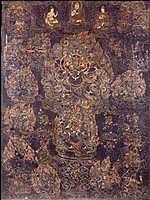
|
Mahakala Chakdrupa (painting no. 252)
|

View Larger Image |
||||||||||||
|
Sadbhuja Mahakala (Tibetan: nag po chen po chag drug pa, English: the Great Black One with Six Hands); wrathful emanation of Avalokiteshvara. With one face and six hands, the first pair of hands hold a curved knife and skullcup held to the heart, the second pair a human skull garland, trident and an upraised elephant skin, the lower pair hold a damaru drum and lasso. Adorned with a crown, bone and jewel ornaments and a necklace of fifty heads he stands with the right leg bent and left extended atop the body of the elephant headed Ganesh, above a sun disc and lotus seat, completely surrounded by the fires of pristine awareness. At the top center are two lamas performing the 'Dharma Teaching' mudra (gesture), wearing monastic robes and red pandita hats. At the left is the mahasiddha Shavaripa, holding a skullcup. At the right corner is Baiktse Chen, red in colour, with the consort and son immediately below - the 'Goddess of Life' riding a bear and the 'Lord of Life' riding a wolf. At the left corner is the wealth deity 'Wish-fulfilling' White Mahakala, with one face and six hands, in a standing posture. Below is Mahakala 'Gonpo Legden' holding an upraised stick in the right hand and a skull in the left. At the right is Panjara Mahakala holding a curved knife and skullcup, supporting a stick across the forearms, in an unusual stance with the right leg bent Below those are black Jinamitra, red Takkiraja and Kshetrapala riding a bear. At the middle right is Trakshe, 'The Lord of Daemons,' riding a black horse, and below is Shri Devi (Tib.: pal den lha mo) riding a mule; all have one face and two hands. These five belong to the inner retinue of Sadbhuja Mahakala. Directly below the central figure is Caturmukha Mahakala (Tib.: gon po shal shi pa. Eng.: Four-faced Great Black One) the wrathful form of Brahmarupa, with four faces and four hands, surrounded by a retinue of four naked dakinis. At the bottom center is a dancing Brahmarupa with one face and two hands. At the bottom left is Damchen Garwa'i Nagpo holding a hammer in the right hand and riding a brown goat. Next is Kartaridhara Mahakala. At the bottom right is the 'Gyalpo Sum' (Three Kings) of the Sakya School. The upper figure is Tsi'u Marpo the protector of 'Samye Chokor Ling.' Beneath him is Dorje Saitrap and slightly to the left is Dorje Shugden wearing a gold monastic riding hat, holding a vajra in the right hand and a gold vase in the left; riding a black horse. All are mounted on horseback. The subject of the painting is the protector Sadbhuja Mahakala along with various forms of Mahakala. The Gyalpo Sum and Damchen Nagpo are worldly deities. The iconography indicates that the painting belongs to the Sakya School, however the irregularities in the forms would more precisely suggest a sub-school such as Tsar or Bulug (Shalu). The painting style is called 'black scroll' (nag thang). The background is black and the deities are drawn as an outline, often in gold, with more or less colour and detail added at the discretion of the artist. This style of painting is generally reserved for wrathful deities. J.Watt 5-98
|
|||||||||||||
Photographed Image Copyright © 1999 Shelley & Donald Rubin Foundation
|
|
| |
Next Image |